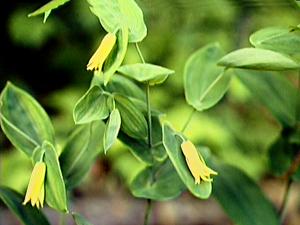 Merry Bells or Bellworts are one of the treasures of our spring forests. They multiply by long, fleshy, white underground stolons and form colonies of delicate stems holding straw-yellow bells nodding in the breeze.
Merry Bells or Bellworts are one of the treasures of our spring forests. They multiply by long, fleshy, white underground stolons and form colonies of delicate stems holding straw-yellow bells nodding in the breeze. Merry Bells or Bellworts are one of the treasures of our spring forests. They multiply by long, fleshy, white underground stolons and form colonies of delicate stems holding straw-yellow bells nodding in the breeze.
Merry Bells or Bellworts are one of the treasures of our spring forests. They multiply by long, fleshy, white underground stolons and form colonies of delicate stems holding straw-yellow bells nodding in the breeze.
We often see two species of this glabrous perennial in our forests. Uvularia perfoliata is unique in the way the stem seems to go right through the leaf-blade. The leaves are elliptic, glaucous and entire. The solitary perfect flower is just over an inch long. There are six tepals (three petals and three sepals) of soft yellow. The fruit is a three-angled pod.
Uvularia sessilifolia is more abundant in the woods. It bears one or two small pale yellow flowers, about an inch long, which droop beneath curving stems. As its name implies, the leaves are sessile, not appearing to be pierced by the stem. It is commonly called Wild Oats. Its capsule is sharply-angled.
Bellworts bloom in April to June. These drooping bell-shaped flowers of the Lily Family, Liliaceae, are among the easiest of wildflowers to grow. Plant them in partially-shaded areas in rich, moist but well-drained soil.
Bellwort was sometimes used to cure throat problems because according to the "doctrine of signatures" it was thought that the blossoms look like the uvula, or palate (that pink appendage which hangs down the back of the throat). " Wort " is a name formerly given to plants used for food or medicine. When used as a suffix, it often just means " plant." The scientific name comes from " the flower hanging like the uvula."
